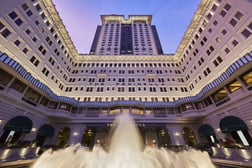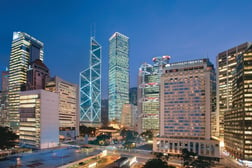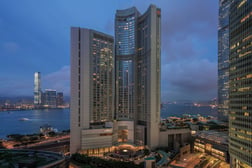Exploring Hong Kong: A Culinary and Cultural Journey
The skyline of Hong Kong is one of the most dramatic in the world, composed of skyscrapers that seem to pierce the clouds. Here is the panoramic view from Victoria Peak down to the impressive glass-and-steel tapestry above bustling streets. It is a complete sensory overload where the smell of street food mingles with murmurs of the city, overwhelming one and involving them at the same time.
11/12/20249 min read


Introduction to Hong Kong
Hong Kong is a vibrant city situated south of China and boasts proudly of its cultural makeup, characterized by the beautiful merger of East and West. This fact emanates from its colonial history, which has modeled the architectural outlook of the city, its food culture, and the social interaction of its people. Today, Hong Kong stands as a beacon of tradition and modernity working together, attracting millions of tourists every year with its rich heritage combined with contemporary charm.
The skyline of Hong Kong is one of the most dramatic in the world, composed of skyscrapers that seem to pierce the clouds. Here is the panoramic view from Victoria Peak down to the impressive glass-and-steel tapestry above bustling streets. It is a complete sensory overload where the smell of street food mingles with murmurs of the city, overwhelming one and involving them at the same time.
Besides its great views, Hong Kong is steeped in history, from the streets to all the cultural attractions. Places like Sheung Wan and Central offer up a plethora of heritage in the form of temples, markets, and colonial buildings-all telling a story behind the historical development of this city. Such a blend of modern developments with historical landmarks makes the intrigue of the city even more comprehensive as the city keeps its past balanced with a hurried present.
Not least of the culinary exploration is from the most chaotic dim sum restaurants to high-end fusion restaurants; all boast a variety of cultural influences. This gastronomic journey thus celebrates not only palates but also insights into the locale and its culture, traditions, and practices that have defined Hong Kong today.
Best Hotels in Hong Kong
When planning a trip to Hong Kong, choosing the right hotel is what will help one be comfortable enough to have an enjoyable stay. Being a vibrant city, accommodation options include everything from high-end, five-star hotels to cozy boutique stays and onto budget-friendly hostels. Each of these has experiences waiting for guests that truly reflect the rich culture and dynamic atmosphere of Hong Kong.
Those who want a more extravagant place to stay will find Hong Kong fully capable of delivering five-star hotels in droves. Known top-of-the-line hotels include The Peninsula, Mandarin Oriental, and Four Seasons-names synonymous with class and superior service. Most of the time, the luxury hotels come complete with great views of Victoria Harbour, fine eateries, and high-scale amenities to truly make the stay one of a kind. Such travelers would do well to book in advance, especially during peak tourist seasons, to ensure the best rates and availability.
While chain hotels offer mainly standardized services, boutique hotels are much more personalized and private. Examples include The Upper House and Hotel LKF. Unique in design, with exclusive service, they invite one to complement the modernity of Hong Kong. These are generally centrally located properties and, thus, suitable for exploring nearby attractions, dining, and nightlife. It is recommended to search through the individual characteristics of the boutique hotel, because most of them focus on local culture and artistry in their messages.
For the more budget-conscious tourists, there is a wide range of hostels and guesthouses in Hong Kong with quite affordable but decent accommodations. Places like YHA Mei Ho House can be explored, and booking websites such as Expedia.com or hotels.com will further assist tourists in finding those places that could fit into budgetary constraints while being hospitable. The same as staying in any place, one should pay attention to location, cleanliness, and facilities such as free Wi-Fi and communal areas so that one has a decent experience.
To travel to Hong Kong, one must put into consideration accommodation needs and personal preferences. Extensive research into these will ensure the best choice of some ideal hotels within a budget or expectation, setting the scene for an unforgettable exploration of this remarkable city.
Must-Try Culinary Delights
Hong Kong is a melting pot where one can enjoy such a variety of flavors, stemming from such a fresh cultural mix. Traditional to gourmet, colorful street-side food-one traveling in this city can indulge in a plethora of flavors that define the culinary scenario of this city. Probably one of the most iconic eating experiences is a dim sum meal, which is one of the major elements of Hong Kong's food culture that any visitor should not miss. It comes served on small steamer baskets, with all varieties consisting of different types of dumplings, buns, and pastries. It is, therefore, an exciting way to have different kinds of food all in one go. Places like Tim Ho Wan and Lin Heung Tea House are pretty popular, having a good deal of authentic dishes that remind one of the beauty this meal holds dear in people's hearts.
Not to be left out, Hong Kong's street food also significantly contributes to the gastronomic appeal of the city. Snacks range from delicious to super delicious and range to affordable dishes from stalls and markets dotting the city. Grilled specialties that are not to be missed include egg waffles, fish balls, and the infamous stinky tofu. Famous Temple Street Night Market and vibrant Mong Kok create a food-savoring atmosphere with its mouthwatering delicacies. Each street food vendor had a flavor of his own, adding vibrancy to Hong Kong street food.
For the ones who want a classier experience in dining, Hong Kong has a list of fine dining restaurants where delicacy meets great view. Restaurants like Aqua and Lung King Heen boast modern twists with a rather exuberant atmosphere. From the humble, nameless food stalls to the most recognized fine dining restaurants, these are not just meals but are an experience unto themselves-a celebration of the city's gastronomic prowess. Be it the charm of dim sum, the fun of street food, or the sophistication of fine dining, Hong Kong has memorable culinary delights that ought to form a part of every visitor's experience.
Local Customs and Etiquette
When visiting Hong Kong, understanding the local customs and etiquette is essential for fostering respectful interactions and ensuring an enjoyable experience. The region boasts a rich blend of traditions influenced by both eastern and western cultures, making it imperative for travelers to familiarize themselves with these practices. One significant aspect of Hong Kong’s social etiquette is the importance placed on politeness and respect, which can be observed in daily interactions. Greetings often include a slight bow and offering a handshake, particularly in formal settings.
Tipping in Hong Kong is generally seen as a gesture of appreciation rather than an obligation. It is customary to leave a tip of around 10% when dining in restaurants, especially if the service charge is not included in the bill. In casual dining or street food establishments, rounding up the total is considered sufficient. Taxi drivers and hotel staff also appreciate small tips, which help convey gratitude for good service.
While exploring the vibrant local markets and cultural sites, travelers should be mindful of cultural taboos. For instance, discussing political issues or sensitive historical events may provoke negative reactions. Additionally, the act of pointing with one finger is considered rude; instead, using an open hand is recommended. Respecting personal space is essential, as Hong Kong can be densely populated, making it critical to navigate crowds with consideration for others.
Dining etiquette is also an integral aspect of Hong Kong's culture. When invited to someone's home, it is customary to bring a gift, such as fruit or sweets, as a token of appreciation. During meals, waiting for the host to initiate the start of dining is polite, and it is common to use chopsticks correctly; the chopsticks should not be stuck upright in rice, since this resembles funeral customs. Observing these local customs and etiquette will significantly enhance one's travel experience in Hong Kong, allowing for meaningful connections with its residents.
Navigating Hong Kong: Transportation Tips
Hong Kong is famous not only for its dynamic culture but also for different transportation systems, all equally efficient. It offers several ways of moving around the city, making it quite easy for visitors to see most of the city attractions. Probably the most popular among them is the Mass Transit Railway: the MTR connects various districts with frequent service. Upon arrival, one has to get himself an Octopus card: a prepaid smart card that makes traveling on public transport much easier.
Supplementing the MTR, buses are also one of the popular modes of transport in Hong Kong. Double-decker buses are one of the good ways to notice the cityscape, as many routes will take you through popular tourists spots or off the beaten track. What travelers should know is that during rush-hour time, in the morning and in late afternoon, buses may be highly packed. For more convenience and with the aim of optimizing travel, it's worth looking at bus schedules in advance.
Other popular methods of transport include ferries, primarily to the surrounding islands such as Lantau and Cheung Chau. The Star Ferry, operating between Hong Kong Island and Kowloon, is also a very efficient way to cross Victoria Harbour as well as providing striking skyline views. It's particularly worth noting the ferry timetables in advance since services vary in frequency throughout the day.
In terms of accessibility, it accommodates people traveling with any mobility issue. Most of the MTR stations are facilitated with elevators and escalators, while many buses are designed to be wheelchair-accessible. It would, however, be prudent to find out about the specific routes beforehand to ensure they will exactly meet particular needs. Generally, the things to understand about different modes of transportation will effectively enhance the experience of exploring Hong Kong and its varied offerings.
Exploring Local Attractions and Hidden Gems
Hong Kong is a dynamic city, housing so many contrasts of modernity with tradition. From visiting the iconic Victoria Peak to riding in the Star Ferry, iconic representations of the city, there is something for everyone. On the other hand, lesser-known places could also be visited to obtain a whole different experience of traveling. These not only give one a real taste of the culture but also allow one to appreciate the multifarious nature of this great throbbing metropolis.
Starting with the famous ones, Victoria's Peak provides fabulous panoramic views of Hong Kong's skyline. Travelers push their way through here to find the city bursting into light for the night, during which time the sky is tinted in shades of gold and crimson. Equally suitable, the Star Ferry is a time-honored means of crossing Victoria Harbor and allows guests to soak in scenic vistas from the water while traveling across from Hong Kong Island to Kowloon. These are all major photo opportunities, which one should not miss in a trip to the city.
To truly experience Hong Kong, though, an exploration of its neighborhoods must take place. For instance, walking through the streets of Sheung Wan, tiny cafes, traditional Chinese medicine shops, and fruit markets slowly begin to show what life is for a Hongkonger. In addition, the serenity of Chi Lin Nunnery and Nan Lian Garden in Diamond Hill offers quiet retreats from hustle and bustle. Equally impressive architecture and beautifully tended landscaping reveal the tranquil side of the city.
Besides these, the various street markets of Mong Kok-like Ladies' Market and Goldfish Market-offer great opportunities for interaction with local people selling food items or other accessories. Freshly prepared snacks like egg waffles and fish balls create aromatic sensations in the air that allure tourists to taste one of the gastronomic wonders. The proper balance between the iconic sights and these real experiences allows travelers to appreciate the cultural richness and charm of Hong Kong.
Conclusion and Final Travel Tips
As this exploration of Hong Kong comes to a close, it is essential to reflect on the richness of its culinary landscape and vibrant culture. This dynamic city is a remarkable destination, offering travelers an array of experiences that blend tradition with modernity. Whether savoring the delights of dim sum or strolling through bustling markets, visitors can immerse themselves in the local way of life.
When planning a trip to Hong Kong, the timing can greatly influence your experience. The best months to visit are typically from October to December when the weather is pleasant, and the city hosts numerous festivals showcasing its cultural heritage. Spring, particularly March to May, is also beautiful, though travelers should be prepared for occasional rain. Ultimately, the off-peak season between June and September can offer more affordable accommodation and fewer crowds, albeit with higher humidity and temperatures.
Preparation is vital for a successful journey. Essential items to pack for your Hong Kong adventure include comfortable walking shoes, lightweight clothing, and an umbrella, as the weather can be unpredictable. A portable charger is highly recommended, considering the extensive use of mobile applications for navigation and dining options, which enhance the overall experience. Additionally, familiarize yourself with local customs and etiquette to respect the culture and foster positive interactions with locals.
As you embrace the vibrant lifestyle of Hong Kong, consider participating in cultural events and visiting lesser-known neighborhoods that reveal the city's multifaceted character. Engage with the community, taste authentic street food, and take time to appreciate the blend of East and West that defines this incredible metropolis. By doing so, you can create lasting memories and gain a deeper understanding of what makes Hong Kong a must-visit destination.






Explore
Travel tips and inspiration for every journey.
Adventure
Connect@scandinaviannomads.com
© 2024. All rights reserved.
